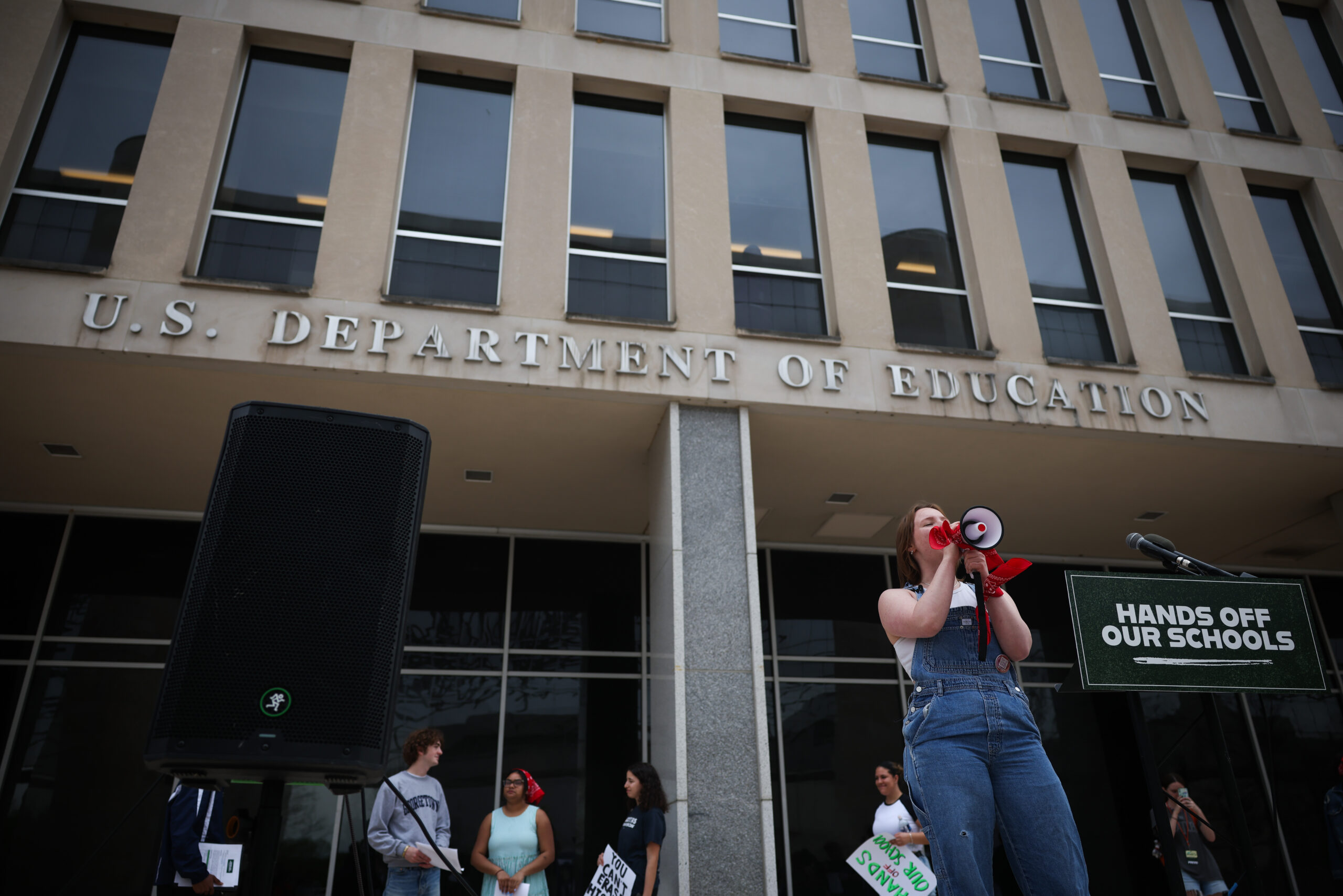David Walrod has taught special education for nearly two decades and has a seventh-grade daughter on the autism spectrum.
He said his heart broke when he learned last month that the Trump administration was using the government shutdown that ended Wednesday as an opportunity to lay off nearly every U.S. Department of Education employee whose job supports special education.
Like other educators around the country, Walrod, a secondary special education teacher in Fairfax County Public Schools in Virginia, feared his special needs students would lose federal protections ensuring their access to free public education that is tailored to their individual needs. He also worried that with reduced federal oversight, there wouldn’t be anyone to step in on behalf of students with disabilities when school districts fail to provide them with legally required services.
“Ultimately, the role of the Department of Education is to protect children like my daughter. It’s to protect children like the students I teach,” Walrod said. “Now, all of a sudden, the federal government is not going to be able to monitor the way that states and localities need them to.”
Walrod’s daughter and his seventh and eighth grade students are among the 7.5 million students with disabilities across the country whose education through public schools is at risk from the Trump administration’s push to move most of the responsibilities of the Department of Education to the states. And like other parents and educators, Walrod is alarmed and anxious about what the future holds if President Donald Trump’s agenda is carried out.
“You might not necessarily see huge changes right away,” he said. “But what you’re going to see is that when things go wrong, there’s not going to be anybody that steps forward and says ‘it’s time to fix this.’”
While special education in the U.S. has never received the support federal officials have promised for decades, it has faced a series of threats during Trump’s second term that have become too big for teachers and families to ignore. In September, the Department of Education canceled millions of dollars in grants for special education teacher training, parent resource centers and related activities. In March, Trump said he would move special education programs to the Department of Health and Human Services. Then just 10 days into the government shutdown, the administration announced that it had cut all staff in the Office of Special Education and Rehabilitative Services, with the exception of a handful of top officials and support staff.
The union representing many Education Department employees, AFGE Local 252, fought the layoffs and said the workers were illegally fired. On Oct. 15, a federal judge paused the layoffs to the Office of Special Education and Rehabilitative Services. The deal to end the 43-day government shutdown reversed those layoffs and will prevent any more through January 30. But it’s only a temporary reprieve, and many teachers, parents and students who rely on these resources are still experiencing a wave of anxiety and uncertainty.
The Department of Education did not respond to Capital & Main’s request for comment. The department’s press office had previously confirmed that the layoffs affected staff at the Education Department but did not provide more details.
In 1975, President Gerald Ford signed the Education for All Handicapped Children Act into law, requiring that states provide all children with any form of disability a free and appropriate education alongside children without disabilities. Prior to the law, only one in five children with disabilities were educated in a public school setting. Some states had laws that excluded children from schools, and many of these children were either homeschooled or institutionalized.

Protesters hold a rally in opposition to the Trump administration’s efforts to dismantle the U.S. Department of Education in Washington, D.C. on April 04, 2025. Photo by Kayla Bartkowski/Getty Images.
In 1990, the law was reauthorized and renamed the Individuals with Disabilities in Education Act and now serves 15% of public-school students nationwide. It’s because of this legislation that children like Walrod’s daughter are able to get the accommodations they need.
Although Walrod’s daughter receives extended time on tests and other assignments as needed, she’s now mostly in a general education classroom. That’s in large part because she was able to get the intensive support that she needed when she was younger, and it helped her catch up to her peers.
But without federal oversight, much of the support that children like Walrod’s daughter receives could be in limbo — and staff and students had already been experiencing a longstanding lack of resources due to insufficient federal funding. “We’re seeing an increase in referrals and requests for support for students with disabilities,” said Nico Vaccaro, a special education educator and the president of Natomas Teachers’ Association, the union representing special education public school educators, teachers and service providers in the Sacramento area. “I think many times it’s felt like districts are playing catchup, instead of meeting the needs of students and educators.”
Since its inception, the Individuals with Disabilities Education Act has never been fully funded by Congress. When the law was enacted, the federal government knew that it would have to share the costs required with states and localities to properly meet the needs of students. But since the amount of funding promised has never been fulfilled, public schools have struggled to keep up with what’s required under the law.
Haley O’Loughlin, a special education lead at Wish Community School, a charter school in the Westchester neighborhood of Los Angeles, is concerned that the more funding is cut, the fewer resources schools will have to support children with individualized education plans, legal documents outlining a student’s needs and the necessary services to support their access to the curriculum.
If public schools aren’t able to honor what’s in a student’s plan, parents could have grounds to sue, said O’Loughlin. The special education office hit with layoffs often works with the Office for Civil Rights within the Education Department to investigate allegations of schools violating students’ rights.
Nearly 70% of the complaints OCR handles are related to disability complaints, according to Tom Zembar, an analyst with the National Education Association labor union. (Disclosure: NEA is a financial supporter of Capital & Main.)
“I know a lot of public schools aren’t able to provide those resources effectively, and that’s harmful to the kids,” said O’Loughlin. “By slashing that even more, it makes me nervous about the future of special education.”
Central to the work of special education teachers is creating an education plan for a student with disabilities and providing them with the materials and support they need to succeed inside a general education classroom. This can include anything from speech and occupational therapy to extra time on school work.
The ultimate goal is “full inclusion,” O’Loughlin said, “which means kids of all abilities are in the general education classroom at all times. They’re learning and working on their goals in the class along with their peers, rather than working somewhere else and missing instruction time.”
For full inclusion to work, O’Loughlin said, it takes a lot of staff, a lot of training and a lot of resources.
In March, Trump issued an executive order calling for the closure of the Department of Education, and the administration’s rhetoric since then aligns with that goal. Trump has said he wants to give states and school districts more authority when it comes to funding public education.
The Department of Education serves as a way to disperse funds but is also filled with experts who know the law and can help parents understand their rights. In Fairfax County, where Walrod and his daughter live, the Office of Civil Rights found that students “weren’t receiving a free and appropriate public education” during the pandemic, and as part of a resolution with that office, the county had to compensate parents who had found their own services for students.
“We don’t know where some of that oversight is going,” said Walrod. “Are we going to be able to ensure that school districts, that states, that communities, are doing what they’re supposed to do for children like my daughter, for children like the students that I teach?”
Copyright Capital & Main 2025


 Pain & ProfitNovember 3, 2025
Pain & ProfitNovember 3, 2025
 Column - State of InequalityNovember 6, 2025
Column - State of InequalityNovember 6, 2025
 Latest NewsOctober 20, 2025
Latest NewsOctober 20, 2025
 Latest NewsOctober 29, 2025
Latest NewsOctober 29, 2025
 Latest NewsOctober 22, 2025
Latest NewsOctober 22, 2025
 Column - State of InequalityOctober 23, 2025
Column - State of InequalityOctober 23, 2025
 Column - California UncoveredOctober 24, 2025
Column - California UncoveredOctober 24, 2025
 Latest NewsOctober 31, 2025
Latest NewsOctober 31, 2025


